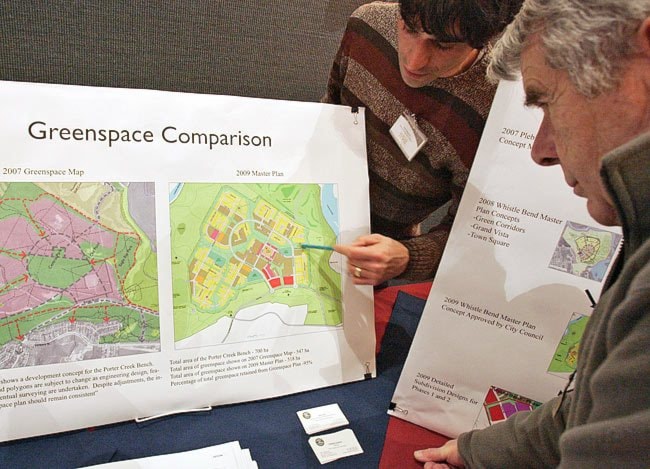Opponents of an access corridor crossing McIntyre Creek hit a roadblock on Thursday.
About 60 residents and city planners packed a tiny conference room at the Whitehorse Westmark Thursday evening to discuss the proposed first and second phase of the Whistlebend subdivision. The proposal is before the Yukon Environmental Socio-economic Assessment Board.
Most attendees wanted to challenge a proposed road to the subdivision that would cut across McIntyre Creek.
They weren’t successful. Because the road is not officially part of the Whistlebend project under review by the assessment board, their concerns about the creek will probably not be considered.
That sparked murmurs in the crowd about the process being “backhanded” and “sneaky.”
The subdivision, projected to grow over the next 25 years, will be Whitehorse’s largest and most densely populated subdivision when it’s finally complete.
Phase 1 and phase 2 will see more than 900 housing units built on the lower Porter Creek bench buttressing the Mountain View golf course.
In December, city planners announced that a road to the Alaska Highway was “necessary” to lessen the traffic burden caused by hundreds of additional cars using Mountain View Drive and Wann Road.
But that connector road, joining the end of Pine Street to the Kopper King, would cut straight through a 37-square-kilometre park the city wants to create to protect McIntyre Creek.
The area is the only wetland left in the city and is considered an important corridor for animals and birds. Disturbing that corridor would have a huge impact on local species, say critics.
At the meeting, planners were repeatedly asked why the road was necessary and why other routes, or an improved transit system, couldn’t be considered instead.
“The connector road has been recommended by experts,” said planning director Mike Gau, referring to an engineering study that singled it out as the cheapest and most feasible route geographically.
The road isn’t officially part of the project, but it was referenced in some of the documents people downloaded from the assessment board’s website.
“If it’s not part of the document, then why am I downloading all this stuff?!” said one angry resident.
City documents focus on phases 1 and 2, but reference future projects, like the Pine Street extension, to support future expansion.
“The connector road is not part of phase 1 and phase 2,” Gau emphasized.
“Once phase 1 and 2 are finished it will be re-examined - it’s a big investment to build that road,” said Gau, explaining alternatives to that route would be more expensive.
The road would only be built when the subdivision had achieved 25 per cent of its population and population numbers in other parts of the city had grown, he explained.
But residents, armed with studies in their hands, challenged him.
“It’s an interesting way to do it,” said one resident.
“To say that you don’t assess now, when you don’t have the demand, is a strange situation because once you do phase 1 and 2 you will have the demand, according to the traffic studies that have been done.”
A few minutes later he referred to a Whistlebend off-site servicing report to further prove his point.
“Existing development in Porter Creek, and the proposed Whistlebend subdivision, will benefit from an extension of Pine Street to the Alaska Highway,” he read.
“It is assumed that this connection can be provided between 10 and 25 per cent buildup.”
Although the connector road wasn’t initially included in the scope of the project, the assessment board will consider adding it to their review, said senior assessment officer Keith Maguire.
Issues of greenspace and geothermal heating were also discussed during the open house.
The meeting dragged on an hour later than scheduled. It was a useful exercise, said Karen Baltgailis, executive director of the Yukon Conservation Society.
“It did seem that Keith (the assessment board’s managing officer) will go back to include the extension as part of the assessment,” she said.
“And I hope that planners see it as being absolutely necessary to do a public consultation on the issue,” suggesting one could be done as part of the 2009 Official Community Plan.
Most importantly, communicating to the public and to city council that the road “isn’t a done deal” and that there are other alternatives to that road is essential, she added.
Contact Vivian Belik at
vivianb@yukon-news.com
